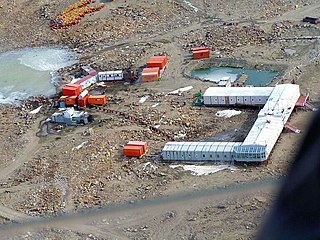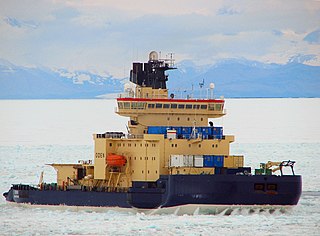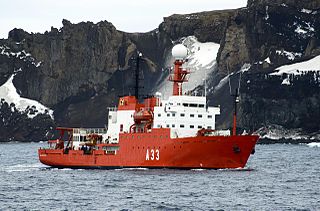
The Canadian Coast Guard is the coast guard of Canada. Formed in 1962, the coast guard is tasked with marine search and rescue (SAR), communication, navigation, and transportation issues in Canadian waters, such as navigation aids and icebreaking, marine pollution response, and support for other Canadian government initiatives. The Coast Guard operates 119 vessels of varying sizes and 23 helicopters, along with a variety of smaller craft. The CCG is headquartered in Ottawa, Ontario, and is a special operating agency within Fisheries and Oceans Canada.

Maitri also known as Friendship Research Centre, is India's second permanent research station in Antarctica as part of the Indian Antarctic Programme. The name was suggested by then-Prime Minister Indira Gandhi. Work on the station was first started by the Indian Expedition which landed there in the end December 1984, with a team led by Dr. B. B. Bhattacharya. Squadron Leader D. P. Joshi, the surgeon of the team, was the first camp commander of the tentage at camp Maitri. The first huts were started by the IV Antarctica Expedition and completed in 1989, shortly before the first station Dakshin Gangotri was buried in ice and abandoned in 1990–91. Maitri is situated in the rocky mountainous region called Schirmacher Oasis. It is only 5 kilometres (3.1 mi) away from the Russian Novolazarevskaya Station.

The Indian Antarctic Programme is a multi-disciplinary, multi-institutional programme under the control of the National Centre for Polar and Ocean Research, Ministry of Earth Sciences, Government of India. It was initiated in 1981 with the first Indian expedition to Antarctica. The programme gained global acceptance with India's signing of the Antarctic Treaty and subsequent construction of the Dakshin Gangotri Antarctic research base in 1983, superseded by the Maitri base from 1989. The newest base commissioned in 2012 is Bharati, constructed out of 134 shipping containers. Under the programme, atmospheric, biological, earth, chemical, and medical sciences are studied by India, which has carried out 40 scientific expeditions to the Antarctic.

The National Centre for Polar and Ocean Research, (NCPOR) formerly known as the National Centre for Antarctic and Ocean Research (NCAOR) is an Indian research and development institution, situated in Vasco da Gama, Goa. It is an autonomous institution of the Department of Ocean Development (DOD), Ministry of Earth Sciences, Government of India which is responsible for administering the Indian Antarctic Programme and maintains the Indian government's Antarctic research stations, Bharati and Maitri. NCAOR was established as NCPOR on 25 May 1998, with Dr. Prem Chand Pandey NCPOR is known for its participation in global experiments, hosting of international conferences and in the leadership of international committees concerned with Antarctic science. At present the chairman of NCPOR is Dr. M. Ravichandran who is also secretary Ministry of Earth Sciences. The present director of NCPOR is Dr. Thamban Meloth At present, NCPOR is an agency working under the Ministry of Earth Sciences, Government of India since 2006, by the notification of the president of India.

Oden is a large Swedish icebreaker, built in 1988 for the Swedish Maritime Administration. It is named after the Norse god Odin. First built to clear a passage through the ice of the Gulf of Bothnia for cargo ships, it was later modified to serve as a research vessel. Equipped with its own helicopter and manned by 15 crew members it has ample capacity to carry laboratory equipment and 80 passengers, functioning independently in harsh Polar ice packs of the Arctic and Antarctic seas. It was the first non-nuclear surface vessel to reach the North Pole, together with the German research icebreaker Polarstern. It has participated in several scientific expeditions in Arctic and Antarctica.

MV Captain Kurbatskiy was a Russian SA-15 type cargo ship originally known as Nizhneyansk (Нижнеянск) after a port of the same name. The ship was delivered from Valmet Vuosaari shipyard in 1983 as the second ship of a series of 19 icebreaking multipurpose arctic freighters built by Valmet and Wärtsilä, another Finnish shipbuilder, for the Soviet Union for year-round service in the Northern Sea Route. These ships, designed to be capable of independent operation in arctic ice conditions, were of extremely robust design and had strengthened hulls resembling those of polar icebreakers.

A research vessel is a ship or boat designed, modified, or equipped to carry out research at sea. Research vessels carry out a number of roles. Some of these roles can be combined into a single vessel but others require a dedicated vessel. Due to the demanding nature of the work, research vessels may be constructed around an icebreaker hull, allowing them to operate in polar waters.

The National Institute of Oceanography, founded on 1 January 1966 as one of 38 constituent laboratories of the CSIR, is a self-governing research organisation in India that conducts scientific research and studies on the unique oceanographic features of the northern Indian Ocean. It is headquartered in Goa and has regional offices in Kochi, Mumbai, and Visakhapatnam.

Vasco da Gama, often shortened to Vasco, is a city in the state of Goa on the west coast of India. It is named after the Portuguese explorer Vasco da Gama. It is the headquarters of the Mormugão taluka (subdistrict). The city lies on the western tip of the Mormugao peninsula, at the mouth of the Zuari River, about 30 kilometres (19 mi) from Panaji, Goa's capital, 28 kilometres (17 mi) from Margao, the district headquarters and about 5 kilometres (3.1 mi) from Dabolim Airport.

The National Institute of Ocean Technology (NIOT) was established in November 1993 as an autonomous society under the Ministry of Earth Sciences in India. NIOT is managed by a Governing Council and is headed by a director. The institute is based in Chennai. The major aim of starting NIOT was to develop reliable indigenous technologies to solve various engineering problems associated with harvesting of non-living and living resources in India's exclusive economic zone, which is about two-thirds of the land area of India.
The Ministry of Earth Sciences was formed on 29 January 2006 from a merger of the India Meteorological Department (IMD), the National Centre for Medium Range Weather Forecasting (NCMRWF), the Indian Institute of Tropical Meteorology, Pune (IITM), the Earth Risk Evaluation Centre (EREC) and the Ministry of Ocean Development.
GC Rieber Shipping is a Norwegian shipping company that operates offshore subsea support vessels, marine seismic vessels and polar logistics and research expeditions. Based in Bergen, Norway it is listed on the Oslo Stock Exchange. A major owner is GC Rieber.

Polar Class (PC) refers to the ice class assigned to a ship by a classification society based on the Unified Requirements for Polar Class Ships developed by the International Association of Classification Societies (IACS). Seven Polar Classes are defined in the rules, ranging from PC 1 for year-round operation in all polar waters to PC 7 for summer and autumn operation in thin first-year ice.

BIO Hespérides (A-33), is a Spanish polar research vessel. She was built in 1990, by Bazán Shipyards of Cartagena, Spain. Hespérides is used to service the research bases in Antarctica, mainly the Spanish Juan Carlos I Antarctic Base, as well as to perform research voyages. It is operated by the Spanish Navy and the responsible of the scientific equipment is the Spanish National Research Council.

The RV Polar Duke is a 219-foot ice-strengthened research vessel built in 1983. Polar Duke was designed specifically for scientific research with wet and dry laboratories, and an electronic workshop and laboratory. The hull is constructed similar to that of an icebreaker, but the ship isn’t as powerful as an icebreaker. It was originally equipped with a stern A-frame crane and helicopter deck; these were both removed in a major refit in 1998.

Prem Chand Pandey is an Indian space scientist, planetary scientist, and academic in the fields of satellite oceanography, remote sensing, atmospheric science, the Antarctic and climate change, and also he is the founding director of the National Centre for Polar and Ocean Research (NCPOR).

SS Polar Chief was a merchant steamship that was built in England in 1897 and scrapped in Scotland in 1952. In her 55-year career she had previously been called Montcalm, RFA Crenella, Crenella, Rey Alfonso, Anglo-Norse and Empire Chief. Early in the First World War she spent eight months pretending to be the battleship HMS Audacious.
Himadri is India's first permanent Arctic research station located at Spitsbergen, Svalbard, Norway. It is located at the International Arctic Research base, Ny-Ålesund. It was inaugurated on the 1st of July, 2008 by the Minister of Earth Sciences. It was set up during India's second Arctic expedition in June 2008. It is located at a distance of 1,200 kilometres (750 mi) from the North Pole.
Bharati is a permanent Antarctic research station commissioned by India. It is India's third Antarctic research facility and one of two active Indian research stations, alongside Maitri. India's first committed research facility, Dakshin Gangotri, is being used as a supply base. India has demarcated an area beside Larsemann Hills at 69°S, 76°E for construction. The research station has been operational since 18 March 2012, though it is still being run on trial basis and formal launch is awaited. Since its completion, India has become one of nine nations to have multiple stations within the Antarctic Circle. Bharati's research mandate focuses on oceanographic studies and the phenomenon of continental breakup. It also facilitates research to refine the current understanding of the Indian subcontinent's geological history. News sources have referred to the station as "Bharathi", "Bharti" and "Bharati".
Fishery Oceanographic Research Vessel Sagar Sampada is an Indian research vessel that is equipped to carry out multidisciplinary research in oceanography, marine biology and fishery science. This is the unique facility of the country equipped to undertake oceanography and fisheries (demersal) in the same platform. The vessel is currently managed and operated by the Centre for Marine Living Resources & Ecology (CMLRE), Kochi, a research institute attached to the Ministry of Earth Sciences, Government of India, and is operated from Kochi. FORV Sagar Sampada is a platform for interdisciplinary expeditions in and around the Indian Exclusive Economic Zone, and in International waters with participation from various institutions, from India and abroad.













